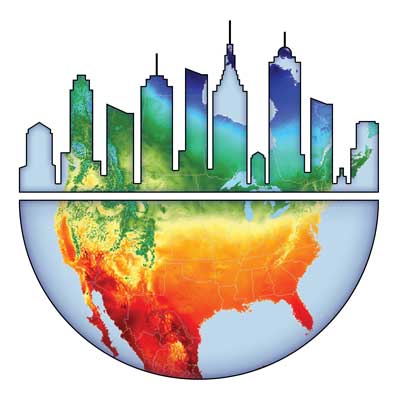Southwest Integrated Field Laboratory
 The Southwest Integrated Field Laboratory project (SW-IFL) led by Arizona State University studies the rapidly urbanizing “megaregion” that stretches across the state of Arizona from the Mexican border in the south to the Navajo (Diné) Nation in the north. This growing urban megaregion is experiencing stresses resulting from warming associated with an expanded urban heat island that is driven by population growth. This region contains one of the fastest growing urban corridors in the United States, including major cities of Tucson, Phoenix, and Flagstaff.
The Southwest Integrated Field Laboratory project (SW-IFL) led by Arizona State University studies the rapidly urbanizing “megaregion” that stretches across the state of Arizona from the Mexican border in the south to the Navajo (Diné) Nation in the north. This growing urban megaregion is experiencing stresses resulting from warming associated with an expanded urban heat island that is driven by population growth. This region contains one of the fastest growing urban corridors in the United States, including major cities of Tucson, Phoenix, and Flagstaff.
With most of the region’s urban areas routinely experiencing 30 or more days of temperatures above 110°F each summer, the population is stressed by the complex interactions of heat, atmospheric pollutants, and limited water. SW-IFL will seek to provide scientists and decisionmakers with high-quality, relevant knowledge to inform response strategies to these concerns.
SW-IFL will develop and deploy novel observational and modeling capabilities that improve understanding of heat as a central driver of key issues that influence desired economic outcomes, and observations as part of the project will leverage existing networks of weather, air quality, and hydrological measurements, supplementing available data with crucial new measurements of land-atmosphere exchange processes, atmospheric composition, and source-receptor relationships.

Phoenix, Arizona. The Southwest UIFL represents one of the fastest growing urban corridors in the United States, including major cities of Tucson, Phoenix, and Flagstaff.
Intensive observational periods throughout the summer months (from hot/arid pre-monsoon months throughout the peak of the North American monsoon season) will use mobile observatories to measure large-scale boundary-layer processes and focused neighborhood-scale heavily instrumented testbed experiments to elucidate drivers of the evolving details of local and urban-scale heat islands and to evaluate the efficacy of proposed solutions.
The integration of new observations with innovations in coupled models across scales will enable high-resolution modeling in the form of the first urban digital twin in the world. Next-generation predictive modeling capabilities for urban regions will be developed by improving representations of fine-scale physical processes while coupling existing state-of-the-art models that integrate socioeconomic information and atmospheric phenomena ranging from neighborhood to regional and global scales. The results will assist decisionmakers in analyzing and evaluating new science relevant to informing solutions that promote effective policy interventions across the region.
Participating Institutions
- Arizona State University
- Brookhaven National Laboratory
- IBM
- Northern Arizona University
- Oak Ridge National Laboratory
- The University of Arizona
